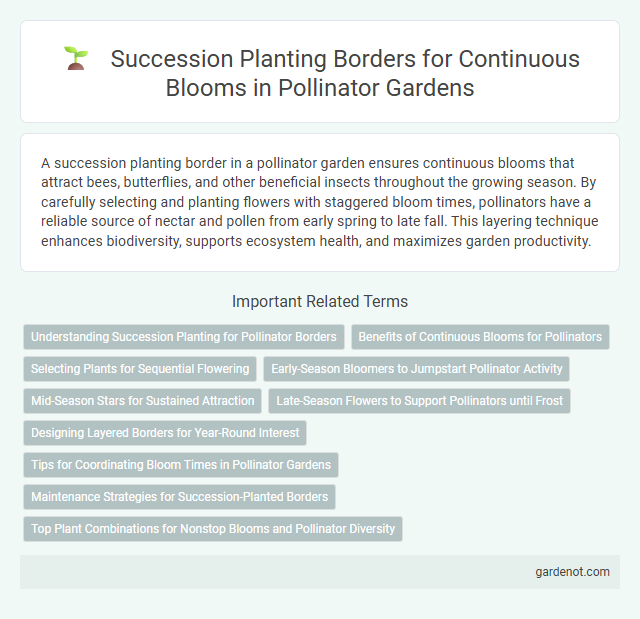A succession planting border in a pollinator garden ensures continuous blooms that attract bees, butterflies, and other beneficial insects throughout the growing season. By carefully selecting and planting flowers with staggered bloom times, pollinators have a reliable source of nectar and pollen from early spring to late fall. This layering technique enhances biodiversity, supports ecosystem health, and maximizes garden productivity.
Understanding Succession Planting for Pollinator Borders
Succession planting in pollinator borders ensures continuous bloom by staggering plantings of nectar-rich flowers, providing consistent food sources for bees, butterflies, and other pollinators throughout the growing season. Selecting native perennials, annuals, and biennials with varying bloom times supports diverse pollinator species and enhances ecological stability. Implementing succession planting maximizes habitat value, promotes pollinator health, and aids in sustaining biodiversity in garden ecosystems.
Benefits of Continuous Blooms for Pollinators
Succession planting borders provide continuous blooms that sustain pollinators by offering a reliable source of nectar and pollen throughout the growing season. This extended availability supports diverse pollinator species, including bees, butterflies, and hummingbirds, enhancing their foraging efficiency and reproductive success. Continuous blooms also promote ecosystem stability by maintaining pollinator populations critical for plant pollination and biodiversity.
Selecting Plants for Sequential Flowering
Selecting plants for sequential flowering in a succession planting border ensures continuous nectar and pollen sources for pollinators throughout the growing season. Incorporate early bloomers like crocuses and snowdrops, mid-season flowers such as coneflowers and zinnias, and late-season favorites like goldenrod and asters to maintain habitat diversity. Choosing native perennial and annual species adapted to local climates supports robust pollinator populations by extending floral availability from spring to fall.
Early-Season Bloomers to Jumpstart Pollinator Activity
Early-season bloomers like crocuses, snowdrops, and hellebores play a crucial role in succession planting borders by providing essential nectar and pollen sources for pollinators emerging from winter dormancy. Incorporating native species such as witch hazel and skunk cabbage supports early pollinator activity, boosting biodiversity and ensuring continuous foraging opportunities. Strategically planting these flowers in succession ensures a seamless transition of resources, promoting healthy pollinator populations throughout the growing season.
Mid-Season Stars for Sustained Attraction
Mid-season stars such as Echinacea, Rudbeckia, and Monarda provide continuous nectar and pollen sources from mid-summer to early fall, ensuring sustained pollinator attraction. Incorporating these perennials into a succession planting border supports diverse pollinator species, including bees, butterflies, and hummingbirds, throughout crucial foraging periods. Strategic layering with varying bloom times extends habitat availability, promoting ecosystem health and enhancing garden resilience.
Late-Season Flowers to Support Pollinators until Frost
Late-season flowers such as asters, goldenrods, and joe-pye weed play a crucial role in succession planting borders by providing essential nectar and pollen sources for pollinators as temperatures drop. Incorporating these species extends the blooming period, supporting bees, butterflies, and hummingbirds until the first frost. Strategic planting of these hardy perennials ensures continuous habitat and food supply, enhancing pollinator health and biodiversity late into the growing season.
Designing Layered Borders for Year-Round Interest
Succession planting in pollinator gardens ensures continuous bloom by layering early, mid, and late-flowering species to attract diverse pollinators throughout the seasons. Design layered borders by combining perennials, shrubs, and groundcovers with staggered flowering times and varying heights, creating visual depth and ecological benefits. Incorporating native plants like Echinacea, Black-eyed Susan, and Aster enhances habitat value and supports sustainable pollinator populations year-round.
Tips for Coordinating Bloom Times in Pollinator Gardens
Choose plant species with staggered bloom periods to ensure continuous nectar and pollen availability for pollinators throughout the growing season. Incorporate early-flowering bulbs like crocus and late-blooming perennials such as asters to extend the garden's active period. Use native plants adapted to local climate conditions to synchronize blooming times naturally and support diverse pollinator species efficiently.
Maintenance Strategies for Succession-Planted Borders
Succession planting borders require regular maintenance strategies such as timely deadheading, targeted pruning, and soil nutrient management to ensure continuous bloom cycles that support diverse pollinator species. Implementing mulch layers helps retain moisture and suppress weeds, reducing competition and stress on pollinator-attracting plants. Regular monitoring for pests and diseases allows for early intervention, maintaining plant health and the overall effectiveness of the pollinator habitat.
Top Plant Combinations for Nonstop Blooms and Pollinator Diversity
Succession planting borders in pollinator gardens maximize nonstop blooms by combining early, mid, and late-season flowering plants, such as lavender, coneflowers, and asters, providing continuous nectar sources for bees, butterflies, and hummingbirds. Incorporating diverse plant species like milkweed, bee balm, and goldenrod enhances pollinator diversity by supporting different insect preferences and life cycles. Strategic layering of height, color, and bloom time creates visual appeal and sustains a thriving ecosystem throughout the growing season.
Succession planting border Infographic

 gardenot.com
gardenot.com